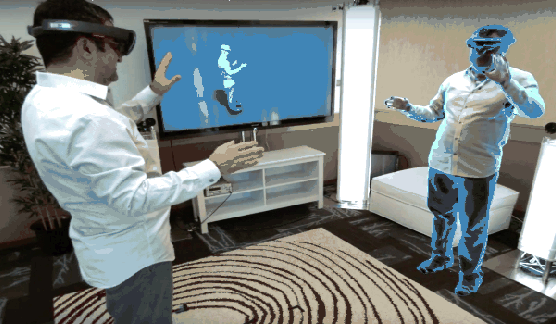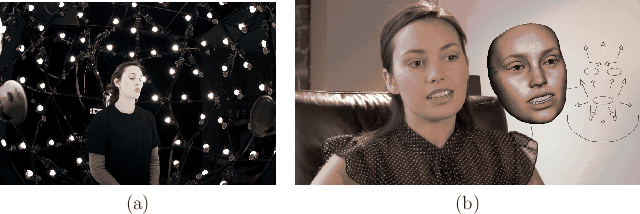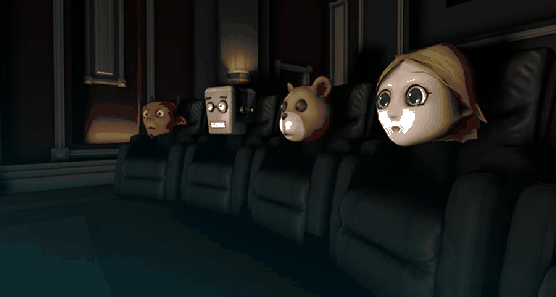
Next: From one-on-one to societies Up: 10.4 Social Interaction Previous: Beyond Shannon-Weaver communication Contents Index
 |
How should others see you in VR? This is one of the most intriguing questions because it depends on both the social context and on the technological limitations. A clear spectrum of possibilities exists. At one extreme, a user may represent himself through an avatar, which is a 3D representation that might not correspond at all to his visible, audible, and behavioral characteristics; see Figure 10.14. At the other extreme, a user might be captured using imaging technology and reproduced in the virtual world with a highly accurate 3D representation; see Figure 10.15. In this case, it may seem as if the person were teleported directly from the real world to the virtual world. Many other possibilities exist along this spectrum, and it is worth considering the tradeoffs.
One major appeal of an avatar is anonymity, which offers the chance to play a different role or exhibit different personality traits in a social setting. In a phenomenon called the Proteus effect, it has been observed that a person's behavior changes based on the virtual characteristics of the avatar, which is similar to the way in which people have been known to behave differently when wearing a uniform or costume [367]. The user might want to live a fantasy, or try to see the world from a different perspective. For example, people might develop a sense of empathy if they are able to experience the world from an avatar that appears to be different in terms of race, gender, height, weight, age, and so on.
Users may also want to experiment with other forms of embodiment. For example, a group of children might want to inhabit the bodies of animals while talking and moving about. Imagine if you could have people perceive you as if you as an alien, an insect, an automobile, or even as a talking block of cheese. People were delightfully surprised in 1986 when Pixar brought a desk lamp to life in the animated short Luxo Jr. Hollywood movies over the past decades have been filled with animated characters, and we have the opportunity to embody some of them while inhabiting a virtual world!
 |
Now consider moving toward physical realism. Based on the current technology, three major kinds of similarity can be independently considered:
For the auditory part, users of Second Life and similar systems have preferred text messaging. This interaction is treated as if they were talking aloud, in the sense that text messages can only be seen by avatars that would have been close enough to hear it at the same distance in the real world. Texting helps to ensure anonymity. Recording and reproducing voice is simple in VR, making it much simpler to match auditory appearance than visual appearance. One must take care to render the audio with proper localization, so that it appears to others to be coming from the mouth of the avatar; see Chapter 11. If desired, anonymity can be easily preserved in spite of audio recording by using real-time voice-changing software (such as MorphVOX or Voxal Voice Changer); this might be preferred to texting in some settings.
Finally, note that the behavioral experience could be matched perfectly, while the avatar has a completely different visual appearance. This is the main motivation for motion capture systems, in which the movements of a real actor are recorded and then used to animate an avatar in a motion picture. Note that movie production is usually a long, off-line process. Accurate, real-time performance that perfectly matches the visual and behavioral appearance of a person is currently unattainable in low-cost VR systems. Furthermore, capturing the user's face is difficult if part of it is covered by a headset, although some recent progress has been made in this area [182].
 |
On the other hand, current tracking systems can be leveraged to provide accurately matched behavioral appearance in some instances. For example, head tracking can be directly linked to the avatar head so that others can know where the head is turned. Users can also understand head nods or gestures, such as ``yes'' or ``no''. Figure 10.17 shows a simple VR experience in which friends can watch a movie together while being represented by avatar heads that are tracked (they can also talk to each other). In some systems, eye tracking could also be used so that users can see where the avatar is looking; however, in some cases, this might enter back into the uncanny valley. If the hands are tracked, which could be done using controllers such as those shown in Figure 10.12, then they can also be brought into the virtual world.
Steven M LaValle 2020-01-06